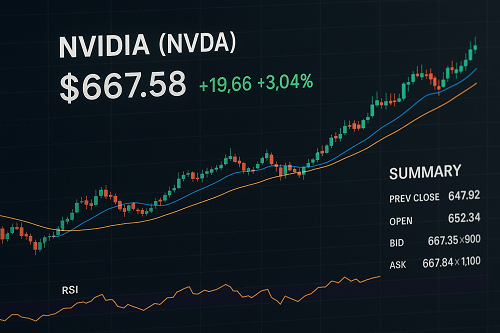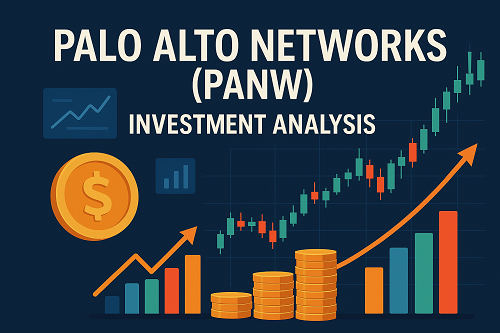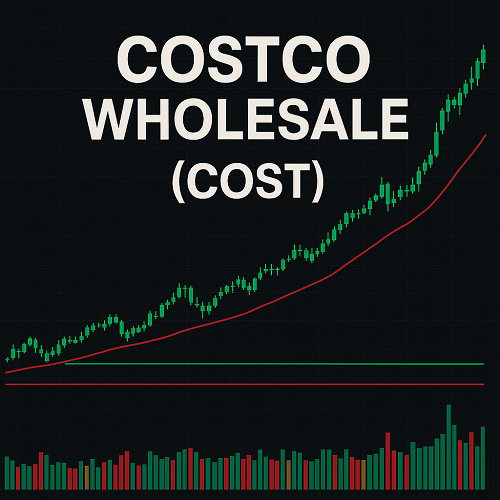NVIDIA Corporation (Ticker: NVDA), prominently listed on Nasdaq as NASDAQ NVDA, has evolved from a graphics processor (GPU) company into a central pillar of the artificial intelligence (AI) revolution. Its GPUs, software stack (CUDA, AI frameworks), and ecosystem investments have made NVIDIA a strategic play on AI, data centers, autonomous systems, and more.
Investors and traders alike are now treating NVDA as more than a semiconductor stock — it is often viewed as a quasi-platform play in AI infrastructure. In this guide, you’ll find everything you need to assess NVDA from both an investment and trading lens.
NVIDIA at a Glance
| Metric | Value / Notes |
|---|---|
| Ticker | NVDA |
| Exchange | Nasdaq (U.S.) |
| Sector / Industry | Information Technology / Semiconductors |
| IPO / Listing | NVIDIA went public on January 22, 1999 |
| Headquarters | Santa Clara, California, USA |
| Founders / CEO | Jensen Huang, Chris Malachowsky, Curtis Priem |
| Recent Stock Split | 4-for-1 split on July 20, 2021 |
| 52-Week Range | (Check latest data provider for updated high and low) |
| Market Cap | (Varies — see live quote) |
(Source: Nasdaq NVDA listing)
NVIDIA is part of the Nasdaq-100 index and a heavyweight within the tech and AI sectors.
Real-Time Price & Market Data
One of the limitations of static pages is that price data is dynamic. Here’s how to present real-time (or near real-time) data in a high-quality article:
- Embed or fetch via APIs (e.g. Nasdaq, financial data providers) the live share price, bid/ask, volume, intraday high/low, % change.
- Provide historical data download links (e.g. monthly, yearly) for readers to analyze trends. The Nasdaq site offers such historical quotes.
- Show key real-time metrics like volume surges, unusual options activity, intraday volatility, etc.
Example (as of this writing; replace with dynamic embed):
NVDA — $XXX.XX (+X.X %) | Volume: XX million | Day Range: $___ – $___
Additionally:
- Pre-market / after-hours pricing
- Comparison vs Nasdaq / S&P / peer indices
- Trend lines / live chart widget
By including live data, your page becomes far more useful than a static quote page.
Business Overview & Key Growth Drivers
To outrank the basic stock-quote page, you need more than price — you need insight, narrative, and data that informs decision-making. Let’s dig into NVIDIA’s business model and growth drivers.
Business Segments
NVIDIA’s revenues and growth derive from multiple segments:
- Gaming GPUs — historically core, though relative share is declining.
- Data Center / AI / Accelerated Computing — fastest-growing segment, powering large-scale AI workloads.
- Automotive & Embedded — autonomous driving, infotainment, robotics.
- Professional Visualization — workstations for design, content creation.
- Other — licensing, software, networking.
Over time, Data Center has become the dominant revenue driver.
Competitive Moats & Tech Edge
- GPU architecture leadership: NVIDIA’s advances (Ampere, Hopper, Blackwell) deliver performance/dollar and performance/watt advantages.
- CUDA / software ecosystem: NVIDIA’s early commitment to developer tools has locked many users into its stack.
- Scale, partnerships & data center deals: The company negotiates directly with hyperscalers (AWS, Microsoft, Google, etc.).
- AI infrastructure dominance: Inference and training workloads favor high-end GPUs; NVIDIA designs specialized chips (e.g. H100, Blackwell).
- Vertical integration & acquisitions: Investments in networking (Mellanox), AI software, tools enhance stickiness.
Market Sizing & TAM
To justify valuation, investors often model:
- AI datacenter TAM — expected to grow at double-digit CAGRs.
- Edge AI, robotics, autonomous vehicles — longer horizon but optionality.
- Cloud offload, model inference services, AI hardware beyond GPUs (e.g. specialized accelerators)
These tailwinds position NVIDIA not just for growth but for multiple ROI levers beyond gaming.
Financials & Valuation
Deep financial and valuation analysis is critical to differentiate your article.
Recent Financial Results
Review most recent quarterly / annual reports:
- Revenue growth, gross margin, operating margin
- Segment revenue breakdown
- CapEx, R&D, operating leverage
- Free cash flow, cash / debt position
- Return on Equity (ROE), Return on Invested Capital (ROIC)
Example: Suppose NVIDIA generated $xxB revenue, net income of $xB, free cash flow margin of xx%, etc. (This should come from most recent 10-K / 10-Q).
Valuation Metrics
Key multiples to calculate (relative to peers & own history):
- Price-to-Earnings (P/E)
- Forward P/E
- Price-to-Sales
- EV/EBITDA
- Price-to-Free Cash Flow
- Price-to-Book
- PEG ratio (growth-adjusted P/E)
Also, build a Discounted Cash Flow (DCF) model:
- Project cash flows for 5–10 years
- Estimate terminal growth rate
- Discount by company’s weighted average cost of capital (WACC)
- Derive implied fair value and compare to current price
Additionally:
- Relative valuation vs peer group (AMD, Intel, Broadcom, etc.)
- Historical average multiples
- Sensitivity table (e.g. terminal growth ±1 %, discount rate ±1 %)
Recent Trends & Margins Pressure
Be sure to analyze margin evolution — in high-growth tech, margin compression (due to R&D, component costs, competition) can erode returns. Discuss how NVIDIA is managing supply chain, scaling, and cost efficiencies.
SWOT Analysis
Summarize a distilled view of strengths, weaknesses, opportunities, threats.
| Strengths | Weaknesses |
|---|---|
| Technology & performance leadership | High valuations / elevated multiples |
| Strong brand / ecosystem lock-in | Dependence on a few large customers |
| Rapid growth in AI / data center demand | Supply chain constraints (silicon, packaging) |
| Financial strength & cash flow | Regulatory / export risks (especially China) |
| Opportunities | Threats / Risks |
|---|---|
| Custom AI accelerators / chips beyond GPU | Rising competition (AI chips from Google, Amazon, etc.) |
| Edge AI, inference, autonomous systems | Geopolitical / export controls (U.S. vs China) |
| AI software / stack monetization | Macro slowdown, interest rates, capital markets downturn |
| AI-as-a-service, hardware-software synergy growth | Regulatory / antitrust scrutiny, IP issues |
Technical Analysis & Chart Patterns
For trading-oriented readers, include a technical breakdown.
Trend & Moving Averages
- Identify support/resistance zones based on past pivots
- Plot 50-day, 200-day moving averages and their crossovers
- Check momentum indicators: RSI, MACD, Stochastic
Chart Patterns
- Is there a bull flag, ascending triangle, double bottom, head & shoulders?
- Volume confirmation on breakouts or breakdowns
- Price channels / trendlines
Momentum & Volatility Metrics
- Average True Range (ATR) as a measure of volatility
- Bollinger Bands compressions / expansions
- On-Balance Volume (OBV) for volume trend confirmation
- Relative Strength vs Market / Sector
Entry / Exit Zones & Risk Management
- Construct potential entry ranges (e.g. pullback to support, breakout above resistance)
- Define stop-loss zones and profit-target zones
- Position sizing, risk/reward ratios (e.g. 1:3 or 1:4)
- Option-based strategies (calls, spreads) for leveraged exposure or hedging
Visual charts (interactive or static) help here — embed high-quality charts.
Forecast & Price Targets
No article aiming to outrank should be shy about modeling the future. Provide scenarios:
Base Case (Moderate Growth)
- Assume 20–30% revenue CAGR over 5 years
- Gradual margin expansion / stability
- Terminal growth of 3–4%
- Discount rate of ~8–10%
This yields a predicted price (e.g. $XXX in 5 years) and a mid-term 12-18 month target (e.g. $YYY).
Bull Case
- More aggressive growth assumptions (e.g. 30–40%+ CAGR)
- Faster margin improvements, AI stack monetization
- Terminal growth 4–5%
- Implied upside to perhaps ~2× or 3× from current levels
Bear / Downside Case
- Slower growth due to macro, AI headwinds
- Margin compression
- Regulatory setbacks or export bans
- Terminal growth 1–2%
- Expected downside or stagnation
Analyst Consensus & Price Targets
Compile and compare analyst price targets — bullish, neutral, bearish. Highlight any outliers and rationale. Use a table:
| Analyst | Firm | Target Price | Rating | Key Assumptions / Notes |
|---|---|---|---|---|
| Analyst A | Firm X | $XXX | Buy | Strong AI growth, margin expansion |
| Analyst B | Firm Y | $YYY | Hold | Valuation already priced in |
| Analyst C | Firm Z | $ZZZ | Sell | Risks from regulation, competition |
Also, show recent target revisions (upgrades/downgrades).
Risks & Catalysts
A high-quality long-form article needs to be balanced. List, explain, and quantify key risks and possible catalysts.
Risks
- U.S. export controls / geopolitical tensions (China, U.S. legislation)
- Competition / commoditization (custom AI chips from Google, ARM, etc.)
- Supply chain issues (silicon shortages, packaging, cooling)
- Valuation compression risk (if growth doesn’t justify multiples)
- Intellectual property / lawsuits / regulations
- Macroeconomic downturn / rate hikes / capital markets stress
Catalysts / Upside Levers
- Breakthrough chip architecture (Blackwell, next-gen)
- AI software / stack monetization (licensing, inference-as-service)
- Expansion into new verticals (autonomous vehicles, robotics, AR/VR)
- Strategic acquisitions / partnerships
- Entry into new geographies / markets
Balance the risk/reward view with quantitative measures where possible.
Trading Strategies (Short, Swing, Long)
To serve both traders and long-horizon investors, propose strategies:
Short-Term / Day Trading
- Use intraday momentum offers — watch pre-market / after-hours gap plays
- Intraday breakouts from consolidation
- Use tight stops, focus on high volume moves
- Use VWAP, RSI, moving average crossovers for signals
Swing Trading (1–4 Weeks)
- Enter on pullbacks to support or upon confirmation of trend resumption
- Use options (vertical call spreads) to cap risk
- Keep an eye on news events (earnings, AI announcements)
- Adjust stops to breakeven once in profit
Long-Term Investing (1+ Year)
- Dollar-cost average into position
- Reassess each quarter based on fundamentals
- Use trailing stops or partial profit-taking on spikes
- Consider hedges (puts or collar strategies) near extended valuations
Emphasize the importance of risk management — never risking more than a fixed % per trade (e.g. 1–2%).
Comparative Peers & Benchmarking
Put NVIDIA in context by benchmarking against peers. Useful comparators:
- Advanced Micro Devices (AMD) — gaming + data center competition
- Intel (INTC) — although more legacy, still a chip competitor
- Broadcom (AVGO) — also semiconductor/firmware plays
- Alphabet / Google / AWS (via AI hardware) — indirect competition
- Custom AI chip makers / startups (Cerebras, Graphcore, etc.)
Compare key metrics:
- Growth rates
- Margins
- R&D intensity
- Valuation multiples
- AI-specific investments
Also compare to sector / index averages (e.g. S&P 500, Nasdaq-100, semiconductor index).
ESG, Corporate Governance & Macro Exposure
To deepen the authority and signal trustworthiness (E-E-A-T), cover non-financial dimensions:
ESG (Environmental, Social, Governance)
- NVIDIA’s sustainability or green initiatives
- Governance structure, board independence, incentive structure
- Employee diversity, social responsibility
Macro & Regulatory Exposure
- Sensitivity to interest rates, inflation, global growth
- China / U.S. tech export regulatory risk
- Semiconductor industry cycles
- Currency, geopolitical, tax regulation impacts
Technological / Industry Risks
- Technological obsolescence
- Shift to alternative architectures (eg. non-GPU accelerators)
- Standardization, open-source hardware, competitive disruption
This fills gaps that basic quote pages often ignore, and strengthens your article’s authority.
Summary & Takeaways
- NVDA is no longer just a GPU stock — it’s viewed as central infrastructure in the AI era.
- Fundamentals remain strong, driven by exponential demand for AI compute, although margin and supply constraints must be monitored.
- Valuation is rich, but justified under aggressive growth assumptions — downside is possible if AI growth disappoints or regulatory shocks emerge.
- Trading opportunities exist across timeframes — from intraday momentum to long-term compounding.
- Risks are real — especially export controls, competition, and macro volatility.





 XAUT-USD
XAUT-USD  AMD
AMD  MARA
MARA  SHOP
SHOP  BULL
BULL  CL=F
CL=F